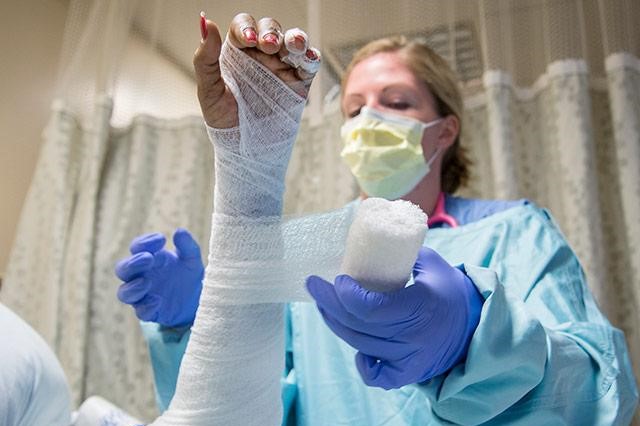
6 facts about burn care that trauma nurses should know
Burn injuries offer unique challenges to trauma nurses. These thermal, electrical and chemical injuries lead to changes in several body systems that require nurses to modify their approach to patient assessment, monitoring and treatment
Following are six facts that will help trauma and emergency nurses evaluate burn injuries accurately and provide burn patients with the optimal care.
TREATMENT OF BURNS IN RESCUE OPERATIONS: VISIT THE SKINNEUTRALL BOOTH AT EMERGENCY EXPO
-
The airway portion of the ABCDE survey should include three extra burn assessments
When conducting the airway portion of the patient survey:
- Inspect the patient’s face for singed facial hair and nose hair.
- Inspect the inside of the patient’s mouth for swelling and/or carbonaceous sputum.
- If the patient can speak, ask them whether they notice any changes to their voice.
All three can be signs of injury to the respiratory system.
These assessments should be performed in addition to the normal inspection for foreign bodies, lacerations, secretions, etc.
-
The ABA recommends the “Rule of Nines” for assessing the extent of burn injury
To provide the correct fluid resuscitation for burn patients, providers must first estimate the patient’s total body surface area (TBSA).
Most centers use the Lund and Browder method of determining TBSA.
However, this method involves mathematical calculations that limit its practicality during the acute resuscitation phase.
The American Burn Association (ABA) recommends using the Rule of Nines for determining the extent of a patient’s burns:
- This method divides the body into regions that each represent 9% of the TBSA (except for the genital region, which is 1% of TBSA).
- For example, the front side of each leg accounts for 9% of the adult body surface. If an adult patient has second-degree and/or third-degree burns to most of the front of both legs, the extent of burns is 18% of TBSA.
There are modified versions of the Rule of Nines for pediatric and infant patients.
-
Precise fluid resuscitation is critical for burn patients
Fluid resuscitation is required for patients with burns to 20% or more of TBSA.
This calculation does not include first-degree burns. As noted above, when estimating percentage of TBSA burned, only count second- and third-degree burns.
There are several formulas for estimating fluid resuscitation needs in the first 24 hours.
For adult thermal and chemical burns, the recommended formula is the Modified Brooke Formula:
2 mL Lactate Ringer’s (LR) x % TBSA x Patient Weight (in kg)
Half (50%) of the total fluid resuscitation volume should be administered in the first 8 hours, and half (50%) should be delivered in the last 16 hours.
Note that the initial 8 hours begins at the time of injury, not at the time of presentation. If a patient presents at your center 2 hours after suffering their burn injury, then you have only 6 hours to administer the first 50% of the fluids.
There are separate formulas and recommendations for pediatric patients and for patients with electrical burns.
For all patients, it is important to monitor urinary output because this will guide any needed adjustments to fluid resuscitation volumes.
-
It is especially important to keep burn patients warm
The skin plays a key role in thermoregulation.
For that reason, burn injuries interrupt the body’s ability to regulate temperature. In addition, shivering increases the patient’s metabolic demand.
It is important to keep this in mind during the exposure portion of the ABCDE survey. All clothing should be removed to enable a full inspection for burns and other injuries.
However, steps must also be taken to keep the patient warm and prevent him or her from shivering:
- Keep the patient covered whenever possible.
- Use heat lamps to increase room temperature.
- Use colloid solutions to help the patient maintain normal body temperature.
-
Burn patients have special nutritional support needs
Burn injuries can cause the patient’s basal metabolic rate to increase up to threefold.
This hypermetabolic state is characterized by a dramatic increase in resting energy expenditure.
As a result, nutritional support is essential for patients with burn injuries.
Giving nutrition via an enteral route reduces the risk of intestinal villous atrophy.
-
Watch burn patients for changes in mental status
Patients with severe burns may require high quantities of narcotic pain medication.
In addition, an increase in metabolic rate can lead to fluctuations in blood glucose levels. Both can cause changes in mental status.
Managing glucose is essential.
Check blood glucose levels frequently and treat according to provider orders or the facility’s blood glucose treatment protocol.
Read Also:
Emergency Live Even More…Live: Download The New Free App Of Your Newspaper For IOS And Android
Wound Infections: What Causes Them, What Diseases They Are Associated With
Patrick Hardison, The Story Of A Transplanted Face On A Firefighter With Burns
Eye Burns: What They Are, How To Treat Them
Burn Blister: What To Do And What Not To Do
Ukraine Under Attack, Ministry Of Health Advises Citizens About First Aid For Thermal Burns
RICE Treatment For Soft Tissue Injuries
How To Carry Out Primary Survey Using The DRABC In First Aid
Heimlich Maneuver: Find Out What It Is And How To Do It


